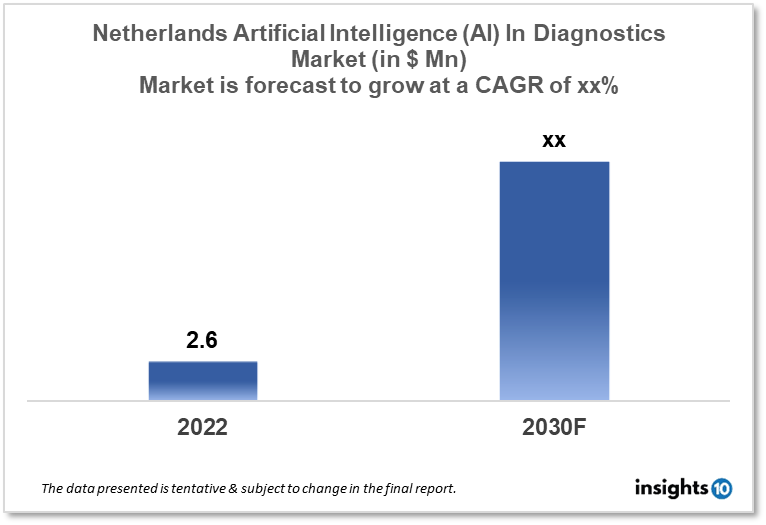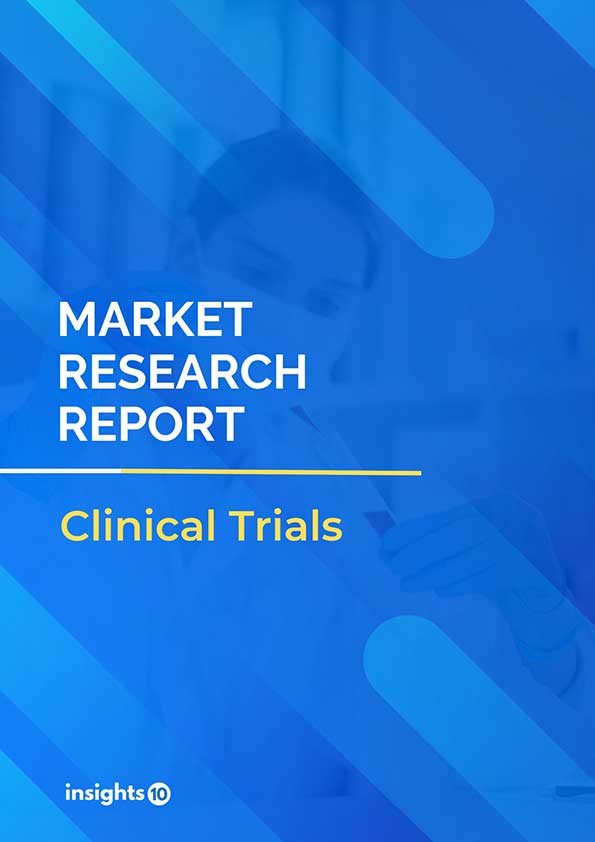Netherlands Artificial Intelligence (AI) in Diagnostics Market Analysis
Netherlands Artificial Intelligence (AI) in the diagnostics market is projected to grow from $2.6 Mn in 2022 to $xx Mn by 2030, registering a CAGR of xx% during the forecast period of 2022-30. The market will be driven by the rising demand for advanced diagnostics and government-led public–private partnership projects. The market is segmented by component & by diagnosis. Some of the major players include Philips Healthcare, IBM Watson Health & Thirona.
Buy Now

Netherlands Artificial Intelligence (AI) in Diagnostics Market Executive Summary
Netherlands Artificial Intelligence (AI) in the diagnostics market is projected to grow from $2.6 Mn in 2022 to $xx Mn by 2030, registering a CAGR of xx% during the forecast period of 2022-30. The Netherlands' healthcare system is noted for having high standards, and adequate facilities, and is accessible to all through a universal healthcare program supplied by private providers. The Netherlands lacks a single-payer healthcare system. Instead, it achieves universal healthcare through mandatory basic private insurance that is controlled and financed by the government. With a GDP of $1 trillion in 2021, the Netherlands is the world's 17th biggest economy and the 5th largest in the European Monetary Union. In 2022, 124.109 people were diagnosed with cancer: 65.591 males and 58.518 women. In the Netherlands, more than 850 people have cancer or have survived cancer.
AI diagnostics have been deployed in a variety of industries in the Netherlands to increase efficiency and accuracy. AI-powered diagnostic technologies, for example, are being utilized to help medical practitioners make accurate diagnoses, improve patient outcomes, and reduce clinical errors. The Netherlands has built a robust ecosystem for the research and use of artificial intelligence in medical diagnostics. With a strong emphasis on cooperation and innovation, the country is well-positioned to continue pushing development in this sector and harness AI to improve patient outcomes and healthcare delivery efficiency.
In April 2022, Aiosyn, a firm that develops AI-powered computational pathology analysis for clinical diagnoses, and Radboud University Medical Center's Department of pathology will collaborate to construct an algorithm for quality management of digital histopathology tissue slides.

Market Dynamics
Market Growth Drivers
The National AI Coalition is a public-private partnership project aimed at accelerating the development and implementation of artificial intelligence in the Netherlands. The coalition, which comprises leaders from government, business, and research institutions, is focused on the use of artificial intelligence in healthcare. Radboud University Medical Center has formed various partnerships with industry partners to create and test AI-based diagnostic tools, and it has also established a specialized research center for AI in healthcare. The AI diagnostics market in the Netherlands is expected to expand significantly in the coming years, driven by a variety of reasons such as increased demand for precision medicine, increasing incidence of chronic illnesses, and a growing necessity for efficient and cost-effective health services.
Market Restraints
Data privacy laws may restrict the availability of big and diverse datasets required to train and build AI algorithms. This can make developing accurate and robust AI diagnosis tools difficult. Furthermore, there are considerations about the ethical and legal consequences of employing AI in diagnostics, which might lead to ambiguity and unwillingness to implement these technologies in particular situations.
The cost of installation and maintenance is another impediment to growth in the AI diagnostics industry. Creating and deploying AI diagnostics tools may be costly, and smaller businesses or organizations with limited resources may struggle to invest in these technologies. Furthermore, ensuring that AI systems are updated and maintained on a regular basis in order to stay accurate and successful necessitates continual investment and assistance.
Competitive Landscape
Key Players
- Philips Healthcare
- IBM Watson Health
- Siemens Healthineers
- GE Healthcare
- Google Health
- AliveCor, Inc.
- Riverain Technologies
- Thirona (NLD)
- ScreenPoint Medical (NLD)
- Aidence (NLD)
- Aiosyn (NLD)
Notable Deals
- February 2023, GE HealthCare to Acquire Caption Health The acquisition adds AI-enabled image guiding to the ultrasound device portfolios of GE HealthCare's $3 billion Ultrasound division
- November 2022, During RSNA 2022, Philips promotes AI-powered diagnostic technologies and transformational workflow solutions
Healthcare Policies and Regulatory Landscape and Reimbursement Scenario
Zorginstituut Nederland is a government institution in the Netherlands that evaluates the effectiveness and cost-efficiency of medical treatments and technology. The agency has formed a working group to investigate the use of AI in diagnostics, with a particular emphasis on assessing the clinical and economic implications of AI-based diagnostic tools.
The Netherlands Healthcare Authority (NZa) is in charge of the regulation and reimbursement of AI diagnostics. The NZa is in charge of maintaining the quality, accessibility, and affordability of healthcare in the Netherlands, as well as fostering innovation and cost-effectiveness. AI diagnostics must fulfill the applicable quality and safety criteria and be included in the List of Reimbursable Medical Devices and Aids to be eligible for payment (G-Standaard).
1. Executive Summary
1.1 Digital Health Overview
1.2 Global Scenario
1.3 Country Overview
1.4 Healthcare Scenario in Country
1.5 Digital Health Policy in Country
1.6 Recent Developments in the Country
2. Market Size and Forecasting
2.1 Market Size (With Excel and Methodology)
2.2 Market Segmentation (Check all Segments in Segmentation Section)
3. Market Dynamics
3.1 Market Drivers
3.2 Market Restraints
4. Competitive Landscape
4.1 Major Market Share
4.2 Key Company Profile (Check all Companies in the Summary Section)
4.2.1 Company
4.2.1.1 Overview
4.2.1.2 Product Applications and Services
4.2.1.3 Recent Developments
4.2.1.4 Partnerships Ecosystem
4.2.1.5 Financials (Based on Availability)
5. Reimbursement Scenario
5.1 Reimbursement Regulation
5.2 Reimbursement Process for Diagnosis
5.3 Reimbursement Process for Treatment
6. Methodology and Scope
Artificial Intelligence (AI) in Diagnostics Market Segmentation
- By Component Outlook Type (Revenue, USD Billion):
- Software
- Hardware
- Services
- By Diagnosis Outlook Type (Revenue, USD Billion):
- Cardiology
- Oncology
- Pathology
- Radiology
- Chest and Lung
- Neurology
- Others
Methodology for Database Creation
Our database offers a comprehensive list of healthcare centers, meticulously curated to provide detailed information on a wide range of specialties and services. It includes top-tier hospitals, clinics, and diagnostic facilities across 30 countries and 24 specialties, ensuring users can find the healthcare services they need.
Additionally, we provide a comprehensive list of Key Opinion Leaders (KOLs) based on your requirements. Our curated list captures various crucial aspects of the KOLs, offering more than just general information. Whether you're looking to boost brand awareness, drive engagement, or launch a new product, our extensive list of KOLs ensures you have the right experts by your side. Covering 30 countries and 36 specialties, our database guarantees access to the best KOLs in the healthcare industry, supporting strategic decisions and enhancing your initiatives.
How Do We Get It?
Our database is created and maintained through a combination of secondary and primary research methodologies.
1. Secondary Research
With many years of experience in the healthcare field, we have our own rich proprietary data from various past projects. This historical data serves as the foundation for our database. Our continuous process of gathering data involves:
- Analyzing historical proprietary data collected from multiple projects.
- Regularly updating our existing data sets with new findings and trends.
- Ensuring data consistency and accuracy through rigorous validation processes.
With extensive experience in the field, we have developed a proprietary GenAI-based technology that is uniquely tailored to our organization. This advanced technology enables us to scan a wide array of relevant information sources across the internet. Our data-gathering process includes:
- Searching through academic conferences, published research, citations, and social media platforms
- Collecting and compiling diverse data to build a comprehensive and detailed database
- Continuously updating our database with new information to ensure its relevance and accuracy
2. Primary Research
To complement and validate our secondary data, we engage in primary research through local tie-ups and partnerships. This process involves:
- Collaborating with local healthcare providers, hospitals, and clinics to gather real-time data.
- Conducting surveys, interviews, and field studies to collect fresh data directly from the source.
- Continuously refreshing our database to ensure that the information remains current and reliable.
- Validating secondary data through cross-referencing with primary data to ensure accuracy and relevance.
Combining Secondary and Primary Research
By integrating both secondary and primary research methodologies, we ensure that our database is comprehensive, accurate, and up-to-date. The combined process involves:
- Merging historical data from secondary research with real-time data from primary research.
- Conducting thorough data validation and cleansing to remove inconsistencies and errors.
- Organizing data into a structured format that is easily accessible and usable for various applications.
- Continuously monitoring and updating the database to reflect the latest developments and trends in the healthcare field.
Through this meticulous process, we create a final database tailored to each region and domain within the healthcare industry. This approach ensures that our clients receive reliable and relevant data, empowering them to make informed decisions and drive innovation in their respective fields.
To request a free sample copy of this report, please complete the form below.
We value your inquiry and offer free customization with every report to fulfil your exact research needs.









































